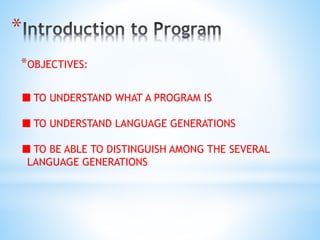
Program & language generation
- 1. * *OBJECTIVES: TO UNDERSTAND WHAT A PROGRAM IS TO UNDERSTAND LANGUAGE GENERATIONS TO BE ABLE TO DISTINGUISH AMONG THE SEVERAL LANGUAGE GENERATIONS
- 2. What is a programming language? What are the two types programming languages? Distinguish among machine language, assembly language and high level language. What is the difference between an assembler, an interpreter and a compiler? What is the difference between source code and object code? *
- 3. * Program is an organized list of instructions that, when executed, it perform any operation, and do the job it is also known a code. Without programs, computers are useless. A program is like a recipe. It contains a list of variables and a list of directions (Statements) that tell the computer what to do with the variables. The variables can represent numeric data, text or graphical images.
- 4. * The term instruction is often used to describe the programming commands. Computer’s instructions set is the list of all the basic commands in the computer's machine language.
- 5. * Computer languages has the same history as the computers itself history. There are five generations of languages when programming method and techniques could be developed as far as development in hardware occurred.
- 6. * First-generation language was machine language or the level of instructions and data that the processor is actually given to work on binary numbers 0s and 1s. First-generation language is the lowest level computer language. Information is conveyed to the computer by the programmer as binary instructions. In the 1940s and 1950s, computers were programmed by scientists sitting before control panels equipped with toggle switches so that they could input instructions as strings of zeros and ones.
- 7. * Second-generation language used assembly language, An assembler converts the assembler language statements into machine language. By the late 1950s, this language had become popular. Assembly language consists of letters of the alphabet. This makes programming much easier than trying to program a series of zeros and ones. Second-generation language use increased when Grace Hopper developed FLOW-MATIC, a language that made programming easier.
- 8. * Third-generation language is a high-level programming language, such as PL/I, COBOL, FORTRAN and C. Compiler based FORTRAN and COBOL created because it improved the record keeping and data management ability in many business applications. In the early 1960s, BASIC language designed and used by nonprofessional programmers. BASIC remained popular during the 1970s and 1980s. Programs written in third-generation languages require more memory and run more slowly than those written in lower level languages.
- 9. * Fourth-generation language is designed to be closer to natural language than a 3GL language. Fourth-generation languages attempt to make communicating with computers as much like the processes of thinking and talking to other people as possible. Fourth-generation languages typically consist of English-like words and phrases, some of these languages include graphic devices such as icons and onscreen push buttons for use during programming and when running the application. Many fourth-generation languages use C, C++, Java and SQL that support stand-alone as well as web applications.
- 10. * Fifth-generation language is programming that uses a visual or graphical development interface to create source language that is usually compiled with a 3GL or 4GL language compiler. Microsoft, Borland, IBM, and other companies make 5GL visual programming products for developing applications in Java, J++, Visual Java, Visual Basic, ASP, ASP.NET, VB.NET and C#. Visual programming allows you to see object oriented structures and drag icons to assemble program blocks.
- 11. A program is a series of instructions given to the computer to perform a task. There are five generations of computer languages. First generation : machine code *
- 12. • What is a program? • Explain briefly the differences between each categories. • State the different types of translators and there functions. • State 2 programming languages in high level. • Is low level languages still used? • State one application where low level language is still used. *